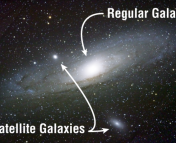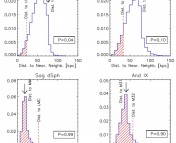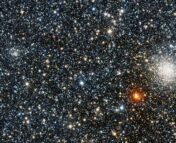English
Title: Six More Ultra-Faint Milky Way Companions Discovered in the DECam Local Volume Exploration Survey
Authors: W. Cerny, C. E. Martínez-Vázquez, A. Drlica-Wagner, A. B. Pace, B. Mutlu-Pakdil, T. S. Li, A. H. Riley, D. Crnojević, C. R. Bom, J. A. Carballo-Bello, J. L. Carlin, A. Chiti, Y. Choi, M. L. M. Collins, E. Darragh-Ford, P. S. Ferguson, M. Geha, D. Martínez-Delgado, P. Massana, S. Mau, G. E. Medina, R. R. Muñoz, E. O. Nadler, K. A. G. Olsen, A. Pieres, J. D. Sakowska, J. D. Simon, G. S. Stringfellow, A. K. Vivas, A. R. Walker, R. H. Wechsler (DELVE Collaboration)
First Author’s Institution: Kavli Institute for Cosmological Physics, University of Chicago, Chicago, IL, USA
Status: Submitted to The Astrophysical Journal, available on arXiv
We live in the Local Group of galaxies, a fairly small group of galaxies, held nearby to one another by their gravitational pull. Three major galaxies make up the Local Group – Andromeda, Triangulum, and our home, the Milky Way – but there’s much more to our neighbourhood than just these three. In fact, dozens of smaller galaxies are scattered in between these, many of which are satellites of either Andromeda or the Milky Way, the two largest members of our group.
The total number of satellites orbiting around the Milky Way is not currently known. The two most massive, the Large and Small Magellanic Clouds, are visible to the naked eye, and have been known ever since humans started studying the night sky. However, this number has grown rapidly in the last 100 years, during which about 60 Milky Way satellites have been discovered. In fact, 80% of these have been found since the year 2000, thanks to huge surveys like the Sloan Digital Sky Survey (SDSS) and the Dark Energy Survey (DES), which can detect incredibly small, faint galaxies that were previously hidden from view (see Figure 1, below).

The new kids on the block
The six satellites were first found as “overdensities” in the DECam Local Volume Exploration (DELVE) survey, which are essentially areas of the sky with more stars than would be expected if the stars were scattered randomly. The DELVE survey is specially designed to search for ultra-faint galaxies, but finding out more about these objects requires more detailed data. For this paper the authors observed them a second time: two of them with a longer exposure on DECam, and the other four using GMOS-N, part of the Gemini Observatory.
They found that all six of these structures had a lot in common. Each is made up of old, metal-poor stars, indicating that they all formed at least ten billion years ago. They are all located between 40-100 kpc (130-330 thousand light years) from the Sun, roughly the same distance as the Magellanic Clouds. However, they are also very small, ranging from 10 to 50 pc in diameter, making them less than a hundredth of the width of the Large Magellanic Cloud.
Three of these are confirmed to be dwarf galaxies, which have intrinsic brightnesses far lower than galaxies like the Milky Way and Andromeda. However, the authors actually conclude that the other three objects are so small they don’t even fit the definition of dwarf galaxies! Instead, they class them as star clusters – these are smaller, lower luminosity, and more spherical than dwarf galaxies, and are thought to be leftover pieces of galaxies that previously approached and collided with the Milky Way. Figure 2, below, shows the size and brightness of these new discoveries, compared to previously discovered dwarf galaxies and star clusters.

The “hiding” satellites problem
Finding these dwarf galaxies and companions around our galaxy is important for several reasons. As galaxies like the Milky Way can grow by merging with smaller galaxies over their lifetime, dwarf galaxies give us an idea of what structures were involved in these mergers. Similarly, star clusters (like those discovered in this paper) let us take a peek at what’s leftover from these past interactions.
Milky Way satellites can also be researched using astronomical simulations, but over time this has led to the “missing satellites problem”, where simulations predict far more satellites around the Milky Way than we actually observe. This problem may have a simple solution though: most of these satellites might actually just be so small that we’ve been unable to see them. Studies like today’s paper provide more evidence that these satellites are not “missing”. Instead, they’re just “hiding”!
It’s likely that many more satellites are still waiting to be found, and the paper concludes by referencing the Vera C. Rubin Observatory, a new telescope due to start operating in 2024, which is hoped to discover more ultra-faint companions. Rubin will observe about half of the night sky in incredible depth, and as this paper shows, there are plenty more dwarf galaxies waiting to be found. Looks like we’re not done getting to know our galactic neighbours just yet!
Astrobite edited by Olivia Cooper
Featured image credit: NASA, ESA, Digitized Sky Survey 2 (Acknowledgement: Davide De Martin) (link)
Nederlands
Titel: Six More Ultra-Faint Milky Way Companions Discovered in the DECam Local Volume Exploration Survey
Auteurs: W. Cerny, C. E. Martínez-Vázquez, A. Drlica-Wagner, A. B. Pace, B. Mutlu-Pakdil, T. S. Li, A. H. Riley, D. Crnojević, C. R. Bom, J. A. Carballo-Bello, J. L. Carlin, A. Chiti, Y. Choi, M. L. M. Collins, E. Darragh-Ford, P. S. Ferguson, M. Geha, D. Martínez-Delgado, P. Massana, S. Mau, G. E. Medina, R. R. Muñoz, E. O. Nadler, K. A. G. Olsen, A. Pieres, J. D. Sakowska, J. D. Simon, G. S. Stringfellow, A. K. Vivas, A. R. Walker, R. H. Wechsler (DELVE Collaboration)
Instituut eerst auteur: Kavli Institute for Cosmological Physics, University of Chicago, Chicago, IL, USA
Status: Ingediend bij The Astrophysical Journal, beschikbaar op arXiv
We wonen in de Lokale Groep van sterrenstelsels, een redelijk kleine groep van sterrenstelsels, die bij elkaar wordt gehouden door hun zwaartekracht. De Lokale Groep bestaat uit drie grote sterrenstelsels – de Andromedanevel, de Driehoeknevel en de onze, de Melkweg – maar in onze omgeving is er veel meer dan deze drie. Er zijn namelijk tientallen kleinere sterrenstelsels verspreid tussen deze grotere sterrenstelsels. Veel van deze kleinere zijn satellieten van de Andromedanevel of de Melkweg, de grootste twee sterrenstelsels van onze groep.
De totale hoeveelheid satellieten die om de Melkweg draaien is nog niet bekend. De grootste twee, de Grote en Kleine Magelhaense wolken, zijn met het blote oog te zien en zijn al bekend zo lang men de sterrenhemel bestudeerd. Tijdens de afgelopen 100 jaar zijn er echter nog ongeveer 60 Melkwegsatellieten ontdekt. 80% hiervan is zelfs ontdekt sinds 2000, dankzij enorme metingen zoals de Sloan Digital Sky Survey (SDSS) en de Dark Energy Survey (DES), die enorm kleine sterrenstelsels die zwak licht geven en dus vroeger verborgen bleven, kan detecteren (zie Figuur 1, hieronder).

De nieuwkomers
De zes satellieten werden eerst gezien als “overdichtheden” in de DECam Local Volume Exploration (DELVE) meting, wat eigenlijk gebieden van de hemel zijn met meer sterren dan we zouden verwachten als de sterren willekeurig verspreid zouden zijn. De DELVE meting is speciaal ontworpen om sterrenstelsels die weinig licht geven te detecteren, maar om meer over deze objecten te weten te komen is er meer data nodig. Voor dit artikel observeerde de auteurs de zes sterrenstelsels nogmaals: 2 ervan met een langere belichtingstijd op DECam en de andere vier met GMOS-N, wat deel is van het Gemini-observatorium.
De auteurs kwamen erachter dat deze zes objecten veel gemeen hadden. Ze bestaan allemaal uit oude, metaalarme sterren, wat aangeeft dat ze alle zes ten minste tien miljard jaar geleden gevormd waren. Ze liggen allemaal op 40 tot 100 kpc (130-330 duizend lichtjaar) van de zon, ongeveer even ver weg als de Magelhaense wolken. Ze zijn echter ook erg klein, van 10 tot 50 pc in diameter, wat ze minder dan een honderdste zo breed maakt als de Grote Magelhaense wolk.
Van drie van deze objecten is het bevestigd dat ze dwergstelsels zijn, ze hebben een veel lagere intrinsieke helderheid dan sterrenstelsels als de Melkweg en de Andromedanevel. De auteurs concluderen daarentegen dat de andere drie objecten zo klein zijn dat ze niet eens binnen de definitie van dwergstelsel passen! Ze worden in plaats daarvan geclassificeerd als sterrenhoop – die zijn kleiner, hebben lagere helderheid en zijn ronder dan dwergstelsels, en men denkt dat ze stukjes van sterrenstelsels zijn die over zijn nadat ze dichter bij de Melkweg zijn gekomen en ermee botste. Figuur 2 hieronder verbgelijkt de grootte en helderheid van deze nieuwe ontdekkingen met eerder ontdekte dwergstelsels en sterrenhopen.

Het “verborgen” satellietenprobleem
Het vinden van deze dwergstelsels en partners rond ons sterrenstelsels is belangrijk om verscheidene redenen. Aangezien sterrenstelsels zoals de Melkweg kunnen groeien door samen te voegen met kleinere sterrenstelsels gedurende hun bestaan, geven dwergstelsels ons een idee over wat voor objecten betrokken waren bij deze samenvoegingen. Op dezelfde manier lichten sterrenhopen (zoals die, die ontdekt zijn in dit onderzoek) het tipje van de sluier op over sommige van deze eerdere interacties.
Melkwegsatellieten kunnen ook onderzocht worden door middel van astronomische simulaties, maar dit heeft op den duur geleid tot het “vermiste satellietenprobleem” (of dwergstelselprobleem), waarbij simulaties veel meer satellieten rondom de Melkweg voorspellen dan dat we observeren. Dit probleem zou echter een makkelijke oplossing kunnen hebben: De meeste van deze satellieten zijn misschien gewoon zo klein dat we zo niet kunnen zien. Artikelen zoals het bronartikel leveren meer bewijs dat deze satellieten niet “vermist” zijn, maar gewoon “verborgen”!
Waarschijnlijk zijn er nog meer onontdekte satellieten, en het artikel sluit af met een verwijzing naar het Vera C. Rubin Observatorium, een nieuwe telescoop die in werking treedt in 2024, die hopelijk nog meer niet heldere objecten zal ontdekken. Rubin zal ongeveer de helft van de nachtelijke hemel observeren tot op een enorme afstand, en zoals dit artikel laat zien, zijn daar nog genoeg dwergstelsels te ontdekken. Het ziet er naar uit dat we nog lang niet klaar zijn met onze buren te leren kennen!
Vertaald door Sjoerd Weide. Ik ben een masterstudent aan de Universiteit Utrecht. Ik werk aan de uitlijning van sterrenstelsels met elkaar, om erachter te komen waar het universum uit bestaat. Daarnaast speel ik graag basketbal en speel ik videogames.
Credit voor de afbeelding: NASA, ESA, Digitized Sky Survey 2 (Erkenning: Davide De Martin) (link)




